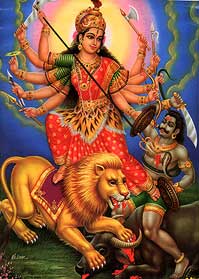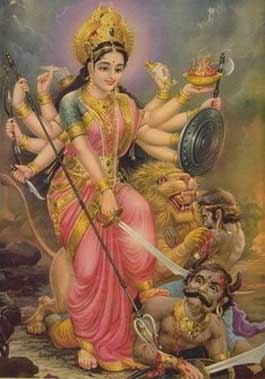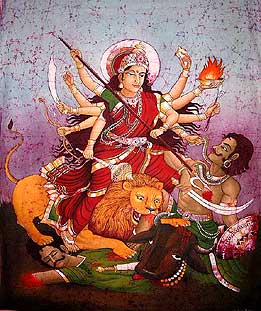Although this festival is not prominent amongst the Sikhs, Guru Gobind Singh in his magnus opus 'The Dasam Granth' narrates three separate compositions in grace of Mother Durga - 'Chandi di Var' in Punjabi, 'Chandi Charitra 1 and Chandi Charitra 2' in Braj. (kanwal)
When the days begin to grow short and the
agonies of floods and epidemics are over, the deep blue sky laughs with its white
feathers of clouds. The south wind grows cooler and drier and veers slowly to
the west. The sweet dews fall; the rice plants stand thigh-high and the earth
is filled with the promise of happiness. It is autumn.
Now is the time to celebrate
Durga Puja, in gratitude for the triumph of good over evil. It is the most important
of Bengali festivals, observed by Bengalis not only in their homeland, but all
over the world, wherever Bengalis live.
The religious ceremony is observed
on the seventh, eighth and ninth days of the moon and the immersion of the image
is on the tenth day, usually in the month of Ashwin (September-October). Durga
Puja is followed by the worship of Lakshmi, the goddess of grace and prosperity,
on the evening of the full moon.
Durga is depicted as a powerful and beauteous
goddess, riding a raging lion, holding aloft ten war weapons in her ten hands.
Her trident is plunged into the side of a monstrous buffalo, out of whose body
there emerges Mahishasura, the dreadful Demon of Evil, only to be vanquished by
the Spirit of Good. (below)

Above
the head of the goddess broods the small figure of Shiva, her lord and the essence
of goodness. On either side are seated her four children: Saraswati the goddess
of learning,Lakshmi the goddess of prosperity, Ganesh the god of fulfilment and
Kartikeya the god of war and purity.
The story of Durga and Mahishasura is
told in the Puranas, the ancient scriptures of the Hindus.
There was once a
terrible demon (asura), who would take the form of a fearful buffalo (mahisha)
and harass the gods. After a hundred years of conflict he succeeded in driving
them out of heaven (swarga) and occupied Indra's own throne. The gods led by Brahma
went to Shiva and Vishnu and prayed for help.
When the two gods heard of the
depredations of the demon, they were so enraged that a strange brightness emanated
from them, which first spread over earth and sky and then condensed into the form
of a glorious goddess. She was named Durga. All the gods endowed her with gifts:
fine silks and ornaments, armour and terrible weapons of war. Himalaya gave her
an invincible lion as a mount.
Then the goddess stretched her thousand arms
in the ten directions of the universe and roared her challenge to the Demon of
Evil. Mahishasura and his followers at once rushed out, armed to the teeth.
A
terrible battle followed; seas were churned and mountains uprooted. The whole
of creation quaked in terror, when a weapon called the pasha, hurled by the goddess,
bound Mahishasura's limbs and made him helpless. Then he assumed many shapes and
still struggled—for evil is strong and persistent—until the goddess
lifted her sword and completely destroyed him.

All
the gods and men bowed in gratitude before Durga and the gracious goddess said,
"Ask a boon of me and it shall be granted." They prayed to her, "Whenever
there is danger and we call upon you, come and deliver us, O Mother." Thegoddess
answered, "So be it."
All ancient religious myths have a single theme:
the eternal struggle between good and evil and the ultimate triumph of good. This
is also the theme of the Durga legend, the origins of which lie in the days long
before the Hindus compiled their religious books. It is a cry of suffering humanity—a
prayer for divine protection from the powers of evil. Hence its universal appeal.
In
the olden days, zamindars and other rich men of the locality performed the Puja,
a costly affair, in their own houses and bore all the expenses. Everyone in the
neighbourhood participated, regardless of caste, creed or social position.
The
religious rites were certainly performed by Brahmins, but the drummers and shehnai-players,
without whose services the ceremony was incomplete, were all Muslim. The residents
of several villages around came not merely as invited guests but as equal participants,
most of whom had an important part to play: the men who cut and brought the bamboos
for the awning; those who put it up; the image-makers; the people who adorned
the images; the decorators; the flower-sellers; the milkmen with their bowls of
curds. The architecture of the old zamindars' houses bears witness to this. There
are the raised covered platforms where the Puja was performed, vast paved courtyards
where a thousand villagers could squat comfortably, huge storerooms and kitchens
with enormous cauldrons and fire-places, carpets, and awnings.
No one was turned
away. All were welcomed and fed sumptuously. New clothes were distributed among
the poor. Today, in place of the old rajas and zamindars, the common people have
come forward. Durga Puja now has even more of the character of a national festival,
in which non-Bengalis andnon-Hindus participate.
Volunteers come out weeks
ahead to collect subscriptions. Sometimes there is trouble, when two Pujas are
performed in the same locality, each party trying to outdo the other, to the distress
of the unfortunate householders. And sometimes film-songs are heard instead of
devotional hymns. Flower-pots have been known to disappear from gardens and flowers
from trees.
A spirit of gaiety is noticeable in the air weeks before the great
occasion. People save up to buy new clothes, new shoes, fine food for the four
days, gifts for friends and relations and for orphans, the sick and poor in hospitals.
Calcutta
is hardly recognisable during Puja week, what with the blazing lights, blaring
music, beautifully decorated Puja pandals, where milling crowds of men, women
and children dressed in their new finery, foregather to see, pray and meet friends.
There
are hundreds of parks and open spaces in the city where Durga Puja is celebrated
every year. Traffic control assumes the proportion of a major civic problem. Main
roads are turned into one-way streets. Benevolent societies make arrangements
to provide drinking water and first-aid if required. Shops are open till late
at night for last minute purchases. Prices of course go up sky high, but who cares?
A spirit of jollity and good fellowship descends upon the citizens, troubles are
forgotten for seven days until Lakshmi Puja is over.
But the merry-making is
not everything; behind it lie serious thoughts, a sense of duty to friends and
neighbours pervades the atmosphere. Good resolutions are made, griefs assuaged,
old enemities forgotten. Behind the lovely clay face of the goddess, there is
the reassurance that when human resourcesfail, there are higher powers to take
over. Hearts fill with strength and joy, not untinged with repentance for past
failings.
Then there are the 'Puja Numbers'. Almost all children's magazines
and papers and many publishers too bring out special, glossy issues filled with
stories, poems and plays, all beautifully illustrated and at remarkably moderate
prices. Established writers as well as many obscure ones put forth their best
efforts. Pocket-money is stored for months and all parental and avuncular resources
tapped, for these are treasures indeed, to be cherished and read again and again.
Needless to say there are 'Puja Numbers' for grown-up readers as well,but they
can never compete with those for the youngsters.
The ladies too have been busy,
making the tasty, dry, economical, traditional sweetmeats that everybody remembers
with nostalgia. These eatables, mostly made of flour, sugar, honey, molasses,
and coconut and flavoured with nutmeg and cardamoms, will keep for weeks. They
are poor man's fare, but fit for kings and are an essential part of the festival.
When the three days of Puja are over, the image is taken down from its pedestal
and started on its final journey to the blowing of conch-shells and calling of
the goddess' name. Trucks, cars, tempos, and carts are requisitioned, or sturdy
shoulders offered eagerly and the image is taken to the river, lake or pond and
plunged into the water. Even the hardiest feel a pang at this moment.
They
shout and sing on their way back and then the Vijaya ceremonies commence. These
are purely social affairs, consisting of visiting friends and relatives, greetings,
embraces and the inevitable sweetmeats. This continues for days after the Puja.
One
must not forget the Puja plays, which contribute a large share to the merry-making.
The plays are selected months ahead; there are favourites which are performed
again and again, but of which neither actors nor audience weary. Parts are copied,
actors chosen and expected to be word-perfect weeks ahead. Then begins the most
enjoyable part: the rehearsals, held almost every day, to the great anxiety of
the guardians of school-goers and examinees. Fortunately Durga Puja comes but
once a year and that during the autumn recess. The social aspect is invaluable.
Whole villages and large zones in cities join in these dramatic efforts. They
are largely amateur endeavours; actors, producers, dressers, decorators, spectators
all composed of the local population, regardless of caste or creed. There are
no higher or lower seats, except that older people and senior patrons may be seated
in front where chairs are provided. Otherwise everybody sits on the ground and
rubs shoulders.
Indeed one might go so far as to say that the whole cultural
and popular life of Bengal blossoms forth at this time, with an exhilarating national
perfume.
Durga Puja means home-comings and reunions. The festival is the highlight
of the year, and when the nights grow longer, the dews fall and the month of Ashwin
is here, hearts quicken in anticipation and faces glow with joy, for Durga Puja
is once more here.
Article taken courtesy of Lila Majumdar from 'Festivals
of India'

